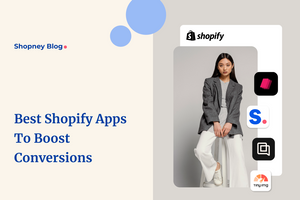
Currently, there are five different generations that engage in online shopping. The interesting thing is, all these generations have different shopping behaviors and preferences.
1. Gen Z (1996 - 2015)
2. Millennials (1977 - 95)
3. Generation X (1965 - 76)
4. Baby boomers (1946 - 64)
5. Silent generation (1945 and before)
Among these generations, Gen Z and millennials have a higher spending power and are most comfortable shopping on mobiles and apps.
So, in this blog, we dissect the online shopping behavior of the two generations that most brands target, and you should too.
Gen Z shopping habits - what you need to know
Gen Z thinks and acts differently from other generations. And hence, it’s critical to understand this generation at a deeper level. For example, Samsung has created Gen Z Lab - an internal group of employees - just to help the brand understand Gen Z, to create content focused on Gen Z lifestyles.
While your brand may not be able to create such labs, you can definitely take note of these Gen Z online shopping behaviors to keep up with this generation.
1. Gen Z is most comfortable with mobile shopping
Generation Z was born just when the mobile phone was born. This generation doesn’t know life without mobile phones. And they don’t know how people shopped before phones — no social media, no quick access to websites, or browsing on the go.
Consider these Gen Z online shopping behavior statistics:
- 33% of Gen Z have bought a product recommended by influencers in the past three months, and 28% of them bought via apps
- 29% of Gen Z make impulse purchases during sales and discounts
Here’s what you can do:
- Ensure you have a comprehensive mobile shopping app for your brand
- Optimize features such as loyalty program, referrals, etc. for mobile
- Integrate different channels such as mobile app, website, social, etc. for a consistent customer shopping experience
2. Gen Z are top buyers on social media
Social media channels are like the second home for Gen Z. They not only use social media for leisure, but also for work, and increasingly for shopping. Most people use social channels on their mobile phones, and hence, customers are now used to browsing products and making purchases on the go via mobile.
Here are some facts about Gen Z mobile usage:
- 80% of Gen Z consumers use Instagram and other social sites for product discovery
- They spend approximately 4.5 hours on social platforms each day
- 97% of Gen Z consumers use social platforms for shopping inspiration
So, how can online retailers leverage this Gen Z shopping habit? Here are some cues:
- eCommerce retailers must engage with Gen Z on multiple social platforms
- 60% are Gen Z consumers concerned about data privacy and so, brands must be transparent about data usage
- Find creative ways to engage Gen Z on social platforms and keep up with trends
- Include social commerce in your sales and marketing plan
3. Gen Z uses mobile phone to discover products
Gen Z is known to browse the internet more than any other generation. They browse the internet to discover products and services as well. And they use their mobile devices for browsing. 74% of Gen Z uses mobile phones to discover and browse products. This makes it extremely important for brands to ensure they show up on search engines when Gen Z are searching and also make their platforms and apps mobile-friendly.
Here are some best practices to match their eCommerce shopping preferences:
- Be consistent with your SEO plan so that Gen Z consumers can discover your brand
- Optimize your website to be mobile-first
- Provide a seamless experience of your website and app on mobile
4. Gen Z expects high-quality ads
Gen Z perceives ads and marketing differently than the previous generations. They are most comfortable with mobile and digital ads. However, this is a generation that has been exposed to an overdose of online ads, and hence, they expect high standards when it comes to ads.
In addition, there’s a peculiar online shopping behavior exhibited by this generation — they look for and are drawn to emotional connection, whether audio or visual ads on streaming channels, apps, or social ads.
Do this:
- Allow skipping and fast-forwarding ads
- Try audio ads - 56% of Gen Z prefer audio as an escape to too much visual content
- Show personalized ads to make it contextual and relevant
- Create gaming ads that offer rewards to engage Gen Z at a deeper level
5. Gen Z like to involved with brands
Gen Z consumers like to be co-creators with brands, not mere consumers. What this means is, they like to be collaborators and partners. Gen Z helps build brands around their own goals, not the other way around. For example, they like to share their opinions, reviews, suggestions, and like products or services tailored to their preferences.
How can brands align with this Gen Z shopping habit?
- Build your brand with your Gen Z customer community, not for them
- Tap into the creator community to market to Gen Z
- Participate with Gen Z via customer-led experiences
- Create online communities for Gen Z on apps and social media
Take a look at this illustration to understand what your brand would need to do to align to Gen Z online shopping behavior:
6. Gen Z are taking to live streams
While subscriptions and memberships did well to help brands generate revenue, now, Gen Z is looking at live streamings to engage, discover products, and buy from brands. Streaming creators are now finding innovative ways to extract more value from their audience beyond passive subscribers. And that’s where eCommerce brands can come in. Here’s how:
- Integrate streaming in your apps via collaboration with influencers
- Host live streaming shows to showcase products and services - for example, tutorials, behind-the-scene, and interviews
- Collaborate with relevant streaming creators or influencers and find ways to reach out to Gen Z consumers
- Create creative ways to cater to Gen Z shopping habits via streaming. For example, use technology such as AR and VR to provide immersive shopping experience
Millennial shopping behavior - what you need to know
Millennials form one of the largest segments of consumers that have seen life before mobile and after. And hence, they are a generation with complex preferences. What is more, they are a mix of people driven by different aspects when it comes to shopping, such as value, quality, image, etc. They have spending power and are easy with shopping via mobile apps, websites, and in-stores. So, let’s look at this generation and how to meet their complex online shopping behaviors.
1. Millennials prefer convenience and speed
Millennials have a high purchasing power and are known for their vibrant lifestyles. When it comes to shopping, they're all about speed and convenience. Whether it's an online store or app, they prefer quick checkout processes, and a hassle-free experience. Meeting millennials’ shopping habits for fast-paced experiences leads to satisfied and loyal customers.
Here’s how brands can cater to millennials via apps:
- Offer fast and dependable shipping services – for example, millennials are used to Amazon Prime’s speedy and complimentary shipping service
- Provide convenient in-store pickup choices and address millennials' desire to sidestep shipping fees while receiving their purchases promptly
- Integrate different channels for a seamless experience, for example, mobile shopping app, website, physical stores, etc.
2. Millennials like loyalty programs
81% of millennials say their spending increases when they are part of loyalty programs by brands. However, there’s a catch. Millennials want loyalty programs to be easy and to offer meaningful rewards. Mere points or discounts are not enough. So how can you create a good loyalty program experience to cater to millennials’ online shopping behavior?
Here’s how:
- Offer meaningful rewards, for example millennials love supporting various social or environmental causes via loyalty programs. 36% of millennials like supporting brands that support LGBTQ rights
- 33% of millennials check their reward points via apps — ensure to optimize your loyalty program for the mobile app
- Millennials are open to paying premium rates for quality and value, hence, ensure you provide the best all round loyalty program experience, whether on app, website or instore
3. Millennials trust recommendations from friends and family
A key millennial shopping behavior is trusting recommendations from friends and family more than advertising and direct marketing. Because they place a lot of importance on value and quality, they rely on recommendations and advice to ensure they buy the best products.
Here’s how to leverage this online shopping behavior:
- When it comes to building brand credibility, reviews take center stage for Millennials. 97% of Millennials read online reviews, with 40% making it a habit to check reviews before making a purchase. Make reviews a part of your web and mobile app shopping
- Create authentic experiences via reviews and recommendations
- Create referral programs to encourage your current customers to refer more customers to your brand
- Millennials are tech-savvy – create app-based experiences around referrals and recommendation programs
4. Transparency influences millennial shopping habits
Just as millennials often look for brands that align with their values, they also prefer brands that are open about their business practices. Transparency and millennials preference for valuable experiences go hand in hand — brands that are transparent and vocal about their principles and values can reach millennial consumers better.
Here’s what you can do:
- Be transparent about how you plan to use customers’ personal data collected via your app and website
- Tell customers where you source products from
- Talk about your values and principles, such as environmental responsibility and diversity, etc.
- Use your app, social media channels and marketing campaigns to stir important conversations
- Millennials like to share about quality products and good experiences with their friends and family, hence, make sharing easy for them via mobile apps
Here’s an example:
5. Create personalized marketing campaigns
Even though millennials are tech-savvy, digital and social media-based advertising may not always work for them. Why? Because 84% of millennials don’t trust advertising and 86% are blind to banner ads. What matters to millennials is relevancy and personalization. They are more drawn to brands that understand them and offer tailored experiences via ads and social content.
So here’s how you can align your marketing to their online shopping behavior:
- Personalize. 56% of millennials reveal their inclination to switch to a brand that tailors its offerings to suit their individual preferences
- Win their hearts with showing them relevant ads, offers, and product recommendations
- Use AI and algorithm to understand what’s on the customers’ mind at a specific time and what is relevant to them presently - use apps that help retain and engage customers
6. Millennials like to feel good about their purchases
60% of millennials tend to choose products, services, and brands that make them feel good about their purchases. For millennials, their online shopping behavior is not only influenced by the products, but rather by the brand connecting with them on a personal level.
Millennials place a higher value on their spending. They want products that not only fulfill practical needs but also cater to their emotional sensibilities. To cater to this distinctive millennial shopping habit, brands can try the following strategies:
- Incorporate socially conscious initiatives that align with millennial values
- Keep your messaging and campaigns consistent across different channels - mobile app, website, social channels, etc.
Ready to meet your Gen Z and Millennial customers?
Both Gen Z and millennials have a high spending capacity, but both have diverse online shopping behaviors. However, a key common thread is their liking to, comfort with, and preference for mobile shopping and apps.
And advanced technology has made it much easier for brands to build apps using no-code mobile app builders. Shopney is one of the most preferred no-code mobile shopping app builders.
You can easily design your shopping app, choose from various themes, integrate other tools, include marketing features, etc.
If you’re looking to get started with the best mobile shopping experiences for your customers, install Shopney today!



